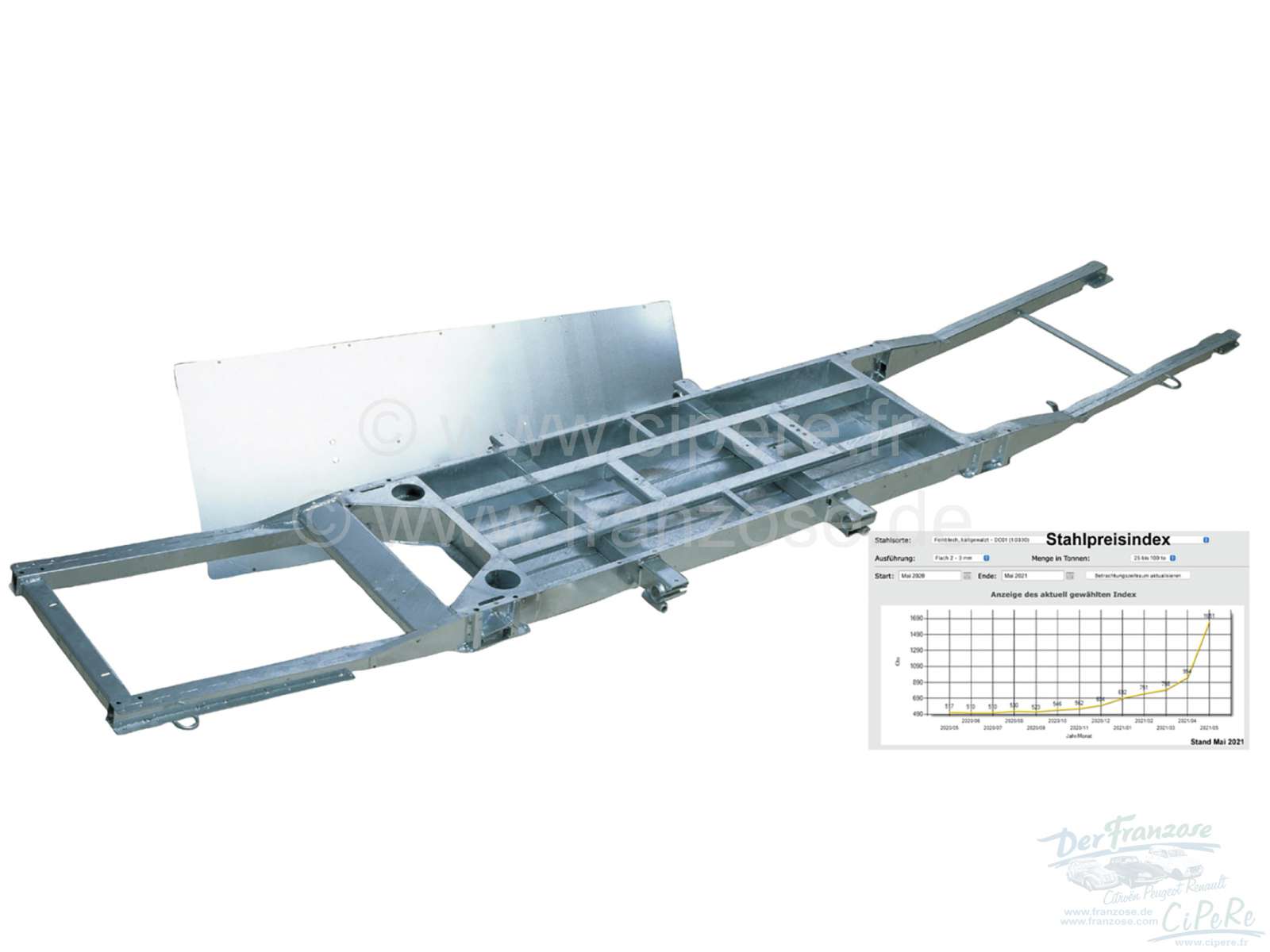Chassis - Once and forever... - Our new chassis
 Finally, the troublesome subject of the 2CV chassis has come to an end! This new chassis has now been produced through collaboration between ‘Der Franzose’ and a specialist equipment construction company.
Finally, the troublesome subject of the 2CV chassis has come to an end! This new chassis has now been produced through collaboration between ‘Der Franzose’ and a specialist equipment construction company.
The benefits of the new chassis are as follows:
• CAD-developed
• Not a prefabricated rod section, but components specially released from stock
• Main body shaped out of one panel with laser cut-outs for taking suspension cylinders etc.
• The tray makes it resistant to distortion, and means only a few welded joints (the risk of making the metal brittle around the welds is therefore avoided!) 
• Extra gusset plates below the axle points
• Extremely well reinforced front axle area
• Fully galvanised by submersion
• Tested on hydropulse equipment in conjunction with the TÜV centre in Hanover (not just a simple test-drive or bending test)
• Additionally tested for distortion resistance by the Hamburg Technical College of Vehicle Engineering
• 150,000km endurance test on the hydropulse equipment without a single problem (the new Swatch car was also tested on the same device)
• Manufactured by one of the leading metalworking companies in Europe (an aircraft industry supplier)
• Manufactured to ISO 9001:2008!
• Fully TÜV-approved
• Additional transverse stiffening to the rear ends of the frame
• The chassis is also naturally supplied ready to take a towing hook
Unlike many cars, the 2CV does not have a self-supporting car body. Instead, its bodywork is built up completely on the chassis. This chassis frame is therefore the 2CV’s load-bearing component, and for reasons of cost is put together in a wonderfully uncomplicated way! A covering sheet of metal on the top and bottom makes it impossible to look at the inside of the chassis, where there are lots of vertical plates spot-welded to the cover panels. This creates a lot of hollow sections that are hard to preserve from rust! Combined with a lack of any underbody coating and the minimal thickness of the panels, these can become rusted through after as little as 5 years. The situation is aggravated by the fact that due to the clever system of panels, up to 3 panels all overlap. It is virtually impossible to create a perfect seal around such a chassis! Even if from the outside the chassis is only rusted through in a few small places that can be quickly sealed up for the car’s roadworthiness test (TÜV, MOT etc.), it is highly likely that rust has also attacked the vertical panels, which are ultimately meant to give the chassis its rigidity. In extreme circumstances, the chassis can even buckle just in front of the rear axle! As a result of this, the rigid steering column can break and you’re no longer able to steer! (You can tell that the chassis has buckled if the steering suddenly becomes very difficult and the size of the gap between the sides of the bonnet and the A-pillar gets smaller!). It's practically impossible to repair a vehicle chassis that this has happened to. We watched on for long enough as 2CV owners suffered these problems and decided in 1997 to develop a vehicle chassis that no longer had the weaknesses of the original.
However, we did things differently to Citroen:
The new chassis has been developed with the help of CAD technology (computer-aided design). The load-bearing element is the angled tray, which only has a single covering panel screwed on top of it, so that you can get at the hollow body at any time! The suspension cylinder sockets are pushed in one piece through laser-cut openings as the chassis is being manufactured. This creates far greater stability than if they were simply welded to the chassis. The tray also has lengthways reinforcements welded onto it that consist of triple-angled profile sections. The longitudinal chassis beams then extend from this tray. Additional gusset plates are welded in place around the area of the front axle and at the axle anchor points. The rear longitudinal beams are also transversely stiffened. The tray makes the chassis very stiff and resistant to distortion. It also doesn’t need many welded joints (the risk of making the metal brittle through welding is thus avoided. For example, none of the abutting edges are fully welded together, instead the corners are laser-cut, thus ensuring that the abutting edge is more flexible). All components are individually made. We do not rely on prefabricated metalwork! All parts are cut by a laser that operates with an accuracy of 0.1mm! Every chassis is made in a large factory in Germany to the ISO 9002 standard. At the customer’s request, the chassis can be galvanised by submersion, when we then give an 11-year anti-perforation guarantee! Our chassis has been tested on hydropulse equipment and has been subjected to an endurance test of 150,000km, fully loaded. We supply your chassis with your vehicle’s chassis number already on it! With every chassis we supply: Free embossing of your chassis number, fitting materials, grease tape for sealing the bodywork to the chassis, a TÜV sample certificate of conformity issued in your name, chassis replacement instructions and a galvanised cover plate. There is no welding work involved in replacing the chassis! All parts on a 2CV are simply screwed together









































